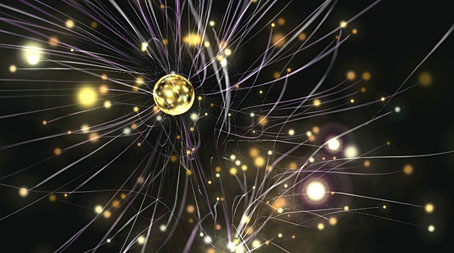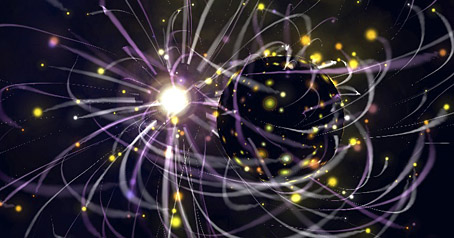
It’s perhaps fitting that in the same week (almost the same day) that the Large Hadron Collider was finally switched on, Apple should release iTunes v. 8.0. The improved Visualizer for this application generates patterns not so far removed from the graphics created to explain quantum interactions or cosmic motion. (And while we’re discussing quantum events, let’s not forget this.)
I enthused last year about the Jelly setting of the Visualizer but these new graphics are a step—a quantum leap, even—beyond that, with a variety of spinning orbs and glowing lights which shoot out streams of sparks and flares of colour. Variations can be had by pressing the M key which cycles through the settings. The abstract fish and/or spermatozoa are especially impressive the way they charge around the screen while their world revolves in three dimensions. If Jelly makes you feel like you’re on drugs, watching these new effects reacting in time to some suitably contemporary music—Aerial by 2562, for instance—makes me feel for once that I’m living in the future I expected to find this side of the year 2000.
• Nature explains what the LHC has actually been built for.

Previously on { feuilleton }
• Aerial by 2562
• From LSD to OSX
• iTunes 7

Couldn’t help thinking of Lovecraft after I downloaded the upgrade:
“I have seen the dark universe yawning ?Where the black planets roll without aim, ?Where they roll in their horror unheeded, ?Without knowledge or lustre or name…”
… but these iTunes cosmic dust clouds, shimmering globes and spirochetes are lustrous indeed! And to paraphrase Uncle Aleister, ‘is there not joy in this endless swooping?’
As you will have guessed, the new visualiser blew my tiny mind (man)! Not too sure how it relates to the music you’re playing though. At least with more primitive versions you got a sense of the imagery corresponding to the rhythms etc. But frankly, who cares when the visuals are this good?
Needless to say, I like those black planets. Messing around with this a bit more has revealed some hidden features: pressing R limits the spiky stuff; pressing S reduces the spikes almost to nothing while pressing A expands them to maximum. Doing the latter makes any beats a lot more apparent.